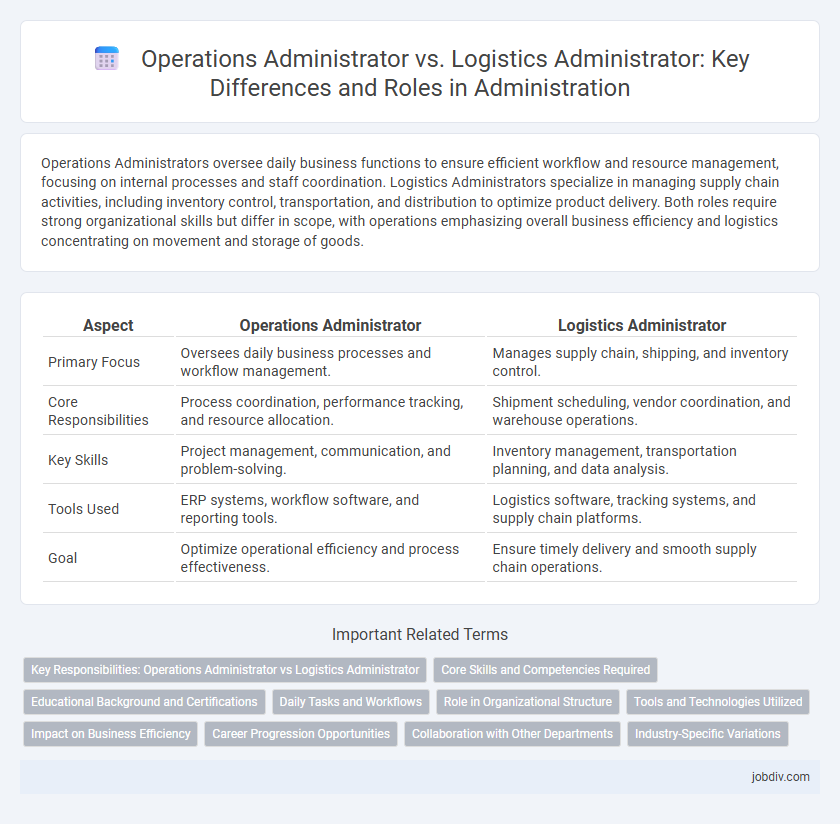Operations Administrators oversee daily business functions to ensure efficient workflow and resource management, focusing on internal processes and staff coordination. Logistics Administrators specialize in managing supply chain activities, including inventory control, transportation, and distribution to optimize product delivery. Both roles require strong organizational skills but differ in scope, with operations emphasizing overall business efficiency and logistics concentrating on movement and storage of goods.
Table of Comparison
| Aspect | Operations Administrator | Logistics Administrator |
|---|---|---|
| Primary Focus | Oversees daily business processes and workflow management. | Manages supply chain, shipping, and inventory control. |
| Core Responsibilities | Process coordination, performance tracking, and resource allocation. | Shipment scheduling, vendor coordination, and warehouse operations. |
| Key Skills | Project management, communication, and problem-solving. | Inventory management, transportation planning, and data analysis. |
| Tools Used | ERP systems, workflow software, and reporting tools. | Logistics software, tracking systems, and supply chain platforms. |
| Goal | Optimize operational efficiency and process effectiveness. | Ensure timely delivery and smooth supply chain operations. |
Key Responsibilities: Operations Administrator vs Logistics Administrator
Operations Administrators manage organizational workflows, coordinate internal processes, and oversee resource allocation to ensure smooth business functions. Logistics Administrators focus on managing supply chain activities, including inventory control, shipment scheduling, and transportation management to optimize delivery efficiency. Both roles require strong communication and problem-solving skills but differ primarily in operational scope versus supply chain logistics.
Core Skills and Competencies Required
Operations Administrators require strong project management, process optimization, and communication skills to coordinate internal workflows and ensure efficiency across departments. Logistics Administrators need expertise in supply chain management, inventory control, and transportation coordination, emphasizing attention to detail and problem-solving abilities to manage the movement of goods. Both roles demand proficiency in data analysis, software tools, and organizational skills, but their core competencies diverge based on operational versus logistical focus.
Educational Background and Certifications
Operations Administrators typically hold degrees in business administration, management, or related fields, often complemented by certifications like Certified Operations Manager (COM) or Project Management Professional (PMP). Logistics Administrators usually possess educational backgrounds in supply chain management, logistics, or industrial engineering, with industry-recognized credentials such as Certified Supply Chain Professional (CSCP) or Lean Six Sigma Green Belt. Both roles benefit from continuous professional development to stay current with evolving operational and logistical frameworks.
Daily Tasks and Workflows
Operations Administrators focus on managing internal processes, coordinating team schedules, and ensuring smooth office functions to enhance organizational efficiency. Logistics Administrators handle supply chain coordination, track shipments, and liaise with vendors to optimize the flow of goods and inventory management. Both roles require strong communication and organizational skills but differ in their operational scope, with Operations centered on internal workflow and Logistics emphasizing external supply coordination.
Role in Organizational Structure
Operations Administrators oversee daily business functions, coordinating multiple departments to ensure efficient workflow and resource allocation within an organization. Logistics Administrators specialize in managing the supply chain, focusing on procurement, distribution, and inventory control to support operational demands. Both roles are critical in organizational structure, with Operations Administrators often positioned higher to integrate cross-departmental activities, while Logistics Administrators report within supply chain or operations units.
Tools and Technologies Utilized
Operations Administrators leverage enterprise resource planning (ERP) systems like SAP and Oracle to streamline workflow management, ensuring efficient resource allocation and real-time data tracking. Logistics Administrators utilize transportation management systems (TMS) such as CargoWise and MercuryGate to optimize shipment scheduling, route planning, and inventory tracking. Both roles often integrate collaboration tools like Microsoft Teams and project management software like Asana for coordinated task execution and communication.
Impact on Business Efficiency
Operations Administrators streamline internal processes by managing workflows, resource allocation, and team coordination, directly enhancing overall business efficiency. Logistics Administrators optimize supply chain activities, including inventory management, transportation, and delivery schedules, reducing costs and improving service reliability. Both roles are critical, with Operations driving internal productivity while Logistics ensures seamless external product flow, collectively boosting organizational performance.
Career Progression Opportunities
Operations Administrators often advance into roles such as Operations Manager or Business Process Analyst, leveraging their broad expertise in workflow optimization and resource management. Logistics Administrators typically progress toward positions like Supply Chain Manager or Logistics Coordinator, specializing in transportation, inventory control, and distribution strategies. Both career paths offer growth potential, with Operations focusing on overall organizational efficiency and Logistics emphasizing supply chain precision and cost reduction.
Collaboration with Other Departments
Operations Administrators coordinate closely with finance, human resources, and IT departments to streamline workflow processes and ensure resource allocation aligns with company objectives. Logistics Administrators work in tandem with supply chain, procurement, and warehouse teams to optimize inventory management and delivery schedules. Both roles demand effective communication and cross-departmental collaboration to enhance overall organizational efficiency.
Industry-Specific Variations
Operations Administrators in manufacturing prioritize workflow optimization, resource allocation, and production schedules, ensuring seamless plant operations. Logistics Administrators in retail focus on inventory management, distribution networks, and supply chain coordination to meet customer demands efficiently. Industry-specific variations highlight that Operations Administrators require in-depth knowledge of production processes, while Logistics Administrators must master transportation logistics and vendor relationships.
Operations Administrator vs Logistics Administrator Infographic

 jobdiv.com
jobdiv.com